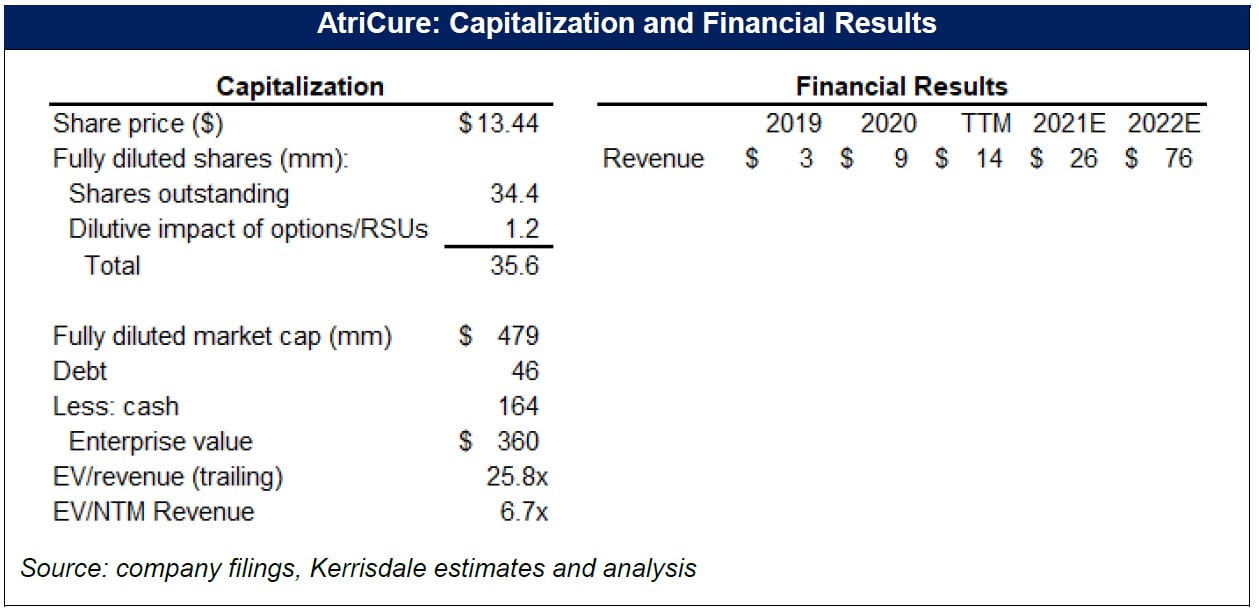Kerrisdale Capital long shares of Acutus Medical Inc (NASDAQ:AFIB).
Q2 2021 hedge fund letters, conferences and more
Acutus Medical - Paradigm-shifting technology at a shocking price
We are long shares of Acutus Medical, a small-cap medical device company that we believe will play a central role in changing the treatment paradigm for persistent atrial fibrillation (AF) and other complex arrhythmias. Evidence that catheter ablation successfully treats less advanced forms of AF has been mounting for years, but persistent AF remains intractable: pharmaceutical intervention rarely succeeds and 30-50% of patients undergoing ablation suffer a relapse into AF in less than a year. Because unresolved AF increases the risk of stroke, heart failure, dementia, and other cardiac disease, the unmet need for treating persistent AF is massive.
Into this treatment void has now stepped Acutus. Its AcQMap catheter is the only cardiac mapping tool that can simultaneously record the electrical activity of an entire atrial chamber of the heart in high resolution, continuously over multiple heartbeats. Within about 3 minutes, the “playback,” an electrical propagation map of the chamber, can be analyzed by an electrophysiologist performing an ablation. The map allows the EP to visualize the pattern of the heart’s electrical conduction, as well as discern various properties of conduction including amplitude, velocity, breadth, and contiguity. Our discussions with numerous EPs confirmed that AcQMap provides a high-resolution visualization of complex atrial arrhythmias that is unrivaled among other mapping tools, and which helps determine an individualized ablation strategy with a precision that has never been possible before.
Already, initial prospective trials suggest that EPs using AcQMap dramatically increase their success rates in ablation for persistent AF. Notably, the trials achieved these efficacy improvements with primitive versions of AcQMap and rudimentary heuristics to determine ablation strategy. AcQMap has since undergone several iterations of improvement and the heuristics, which had been derived from a combination of legacy theories of AF conduction and early feasibility studies of AcQMap, are adapting to incorporate more real-world experience from AcQMap-guided ablation. As that experience mounts, it will translate into the most robust AF-conduction dataset ever. A rigorous taxonomy of conduction phenomena will enable precision characterization of the severity and prognosis of AF, which will further inform individualized ablation strategy for EPs using AcQMap and lead to better outcomes.
Acutus’s stock came under pressure earlier this year as suspicion arose that its 2021 revenue guidance reduction stemmed more from a lack of customer interest in AcQMap than from transient pandemic-related turmoil. Based on discussions with industry participants, we’re confident the snag in momentum is temporary. For one, the pandemic did hit hospital new product procurement especially hard, and that’s reversing now. Additionally, the perceived lack of customer interest in AcQMap is merely a sign that Acutus’s previously indiscriminate approach to sales resulted in AcQMap installations at labs uninterested in precision ablation methods. Acutus’s recently revamped targeted sales efforts are already on track and have already borne fruit in the first half of this year.
As Acutus gains momentum and expands its product offering to RF and pulsed-field ablation catheters, the company will gain substantial share of a now-$5-6 billion catheter ablation market growing at a mid-teens rate. That market growth rate will also soon inflect upward as faster ablation methods become mainstream and guidelines change to reflect recent evidence of the superiority of ablation as an early-stage therapy to treat AF. We expect Acutus to easily gain over 10% market share in the medium term, by which time the company will be a billion-dollar cardiology juggernaut. Given its current $480 million valuation, the returns over that time will be electrifying.
I. Investment Highlights
Acutus’s cardiac mapping technology is revolutionary for the field of electrophysiology. The standard second line treatment for atrial fibrillation (AF), in patients for whom anti-arrhythmic drugs (AADs) no longer work or aren’t tolerated well, is cardiac catheter ablation, a procedure in which an electrophysiologist (EP) inserts a catheter into the heart and carefully burns (or freezes) specific areas of tissue. The scarring is meant to block the dysregulated electrical conduction that’s responsible for the arrhythmia. For patients with early-stage AF, in which the arrhythmia is sporadic, or “paroxysmal,” catheter ablation has a relatively high success rate, with 70-80% of patients remaining arrhythmia-free in the twelve months after the procedure, and 60-70% permanently rid of it over time.
For patients with more persistent forms of AF, or for paroxysmal patients who relapse into persistent AF even after undergoing ablation, the prognosis has not been as constructive. Paroxysmal AF is understood to be the result of errant conduction triggers in the area of the pulmonary veins in the heart’s left atrium, which are relatively straightforward to ablate. Persistent AF, on the other hand, has been much more elusive, with no clear cardiac region having been shown to trigger the arrhythmia. Two different approaches within the field of electrophysiology have emerged in response to the low rates of effectiveness in ablating persistent AF:
- Empirical ablation approach – physicians of the empirical ablation school will ablate pre-specified regions of the endocardium, most prominently the posterior wall of the left atrium, but also near the superior vena cava (SVC), the coronary sinus, and other areas. The logic of empirical ablation is that these sites have been shown to trigger AF in some patients, so ablating them will increase the odds of procedural success.
- Mechanism-based approach – physicians of this school will use advanced 3D mapping catheters to detect abnormal electrical conduction across the atrial endocardium and ablate the areas from which they seem to emanate.
For patients with persistent AF, both approaches do improve on the effectiveness of just isolating the pulmonary veins, but not by much. A substantial proportion of patients (a third to a half) will still end up relapsing into AF or other atrial arrhythmias (such as atrial flutter or atrial tachycardia, a category generally referred to as supraventricular tachycardia, or SVT).
We think Acutus’s AcQMap, a 3D mapping catheter that was first developed and used in humans in 2013, will revolutionize mechanism-based ablation. Prior to AcQMap, the most cutting-edge mapping technology used in the EP lab has been the CARTO 3D contact mapping system from Biosense Webster. But as our extensive discussions with EPs has impressed upon us, even the best contact mapping systems suffer from significant limitations in painting a picture of the atria’s electrical conduction patterns. Contact mapping catheters can only touch the tissue at a few neighboring points at once, which means that the resulting “map” of electrical activation is actually a mosaic of fragmentary electrical measurements taken over the course of 10-40 minutes (depending on the skill level of the physician), and in which the areas that are not directly touched by the electrodes on the catheter are not as accurately depicted. The problem measuring electrical activation this way is that complex arrhythmias – like persistent AF or atrial flutter – are unstable, both temporally and spatially, and stitching up the fragmented measurements results in a necessarily distorted view of the errant electrical conduction. That can sometimes help but, given the current state of mechanism-based ablation, not often enough.
AcQMap, on the other hand, is a non-contact catheter that’s inserted into one of the atrial chambers and, using its 48 electrodes and 48 ultrasound transducers, assembles not just a picture, but a recording over the span of multiple heart beats, of the entire chamber’s electrical activation simultaneously, and in resolution that is 4-10x higher than the best resolution available from the most advanced contact mapping catheters. The best analogy to explain this, as one EP explained to us, is that the most advanced contact mapping system can only return an HD-quality panorama photo composed of images that were separately photographed over a long enough period of time that the disjointedness is noticeable when closely observed. AcQMap, meanwhile, allows the EP to observe the chamber’s electrical activation as a short video recorded and played back in 8K picture quality. AcQMap opens a whole new chapter in observing, researching, and ablating complex arrhythmias like persistent AF.
AcQMap increases the success rate of ablation procedures and improves their safety and efficiency. The initial studies run using AcQMap have given, in our view, just a small glimpse of what we think the technology will enable. In the UNCOVER AF trial, EPs with no prior experience using AcQMap were trained to use the system to detect three conduction patterns that were identified by investigators running the early feasibility studies on AcQMap. When ablating the sites of these patterns, the clinical success rate of ablation in persistent AF patients was better than any achieved in any rigorous study of empirical or mechanism-based ablation. In a second study, conducted independently by two electrophysiology labs using AcQMap, the EPs adjusted the ablation method that was pioneered in the early Acutus feasibility studies. The modest adjustment was made based on prior research into electrical conduction patterns, and it resulted in one-year effectiveness of ablation that completely blew away anything that has ever been achieved before in any large scale study of ablation for persistent AF.
The iterative improvement in using AcQMap has only just begun. The breadth and depth of data on arrhythmic cardiac conduction that is now obtainable through AcQMap will be used to assemble a rigorous taxonomy of conduction patterns and properties. These will be studied in order to plumb their relationships to clinically relevant observations and outcomes, such as how they affect patient prognosis, how they relate to bio-anatomical phenomena like cardiac fibrosis, and how effective will ablating them be in avoiding any recurrence of arrhythmia. Several prominent EPs, some in conjunction with Acutus and others independently, have already begun this kind of research, and only EPs using AcQMap will be able to exploit the clinical insights of this kind of research.
Read the full article here by Kerrisdale Capital







